What are DevOps practices?

DevOps combines software development and operations (administered processes and services) to streamline internal processes, including planning, design, coding, thorough testing and delivery of the created product. DevOps resembles the popular Agile methodology, but these two shouldn’t be confused.
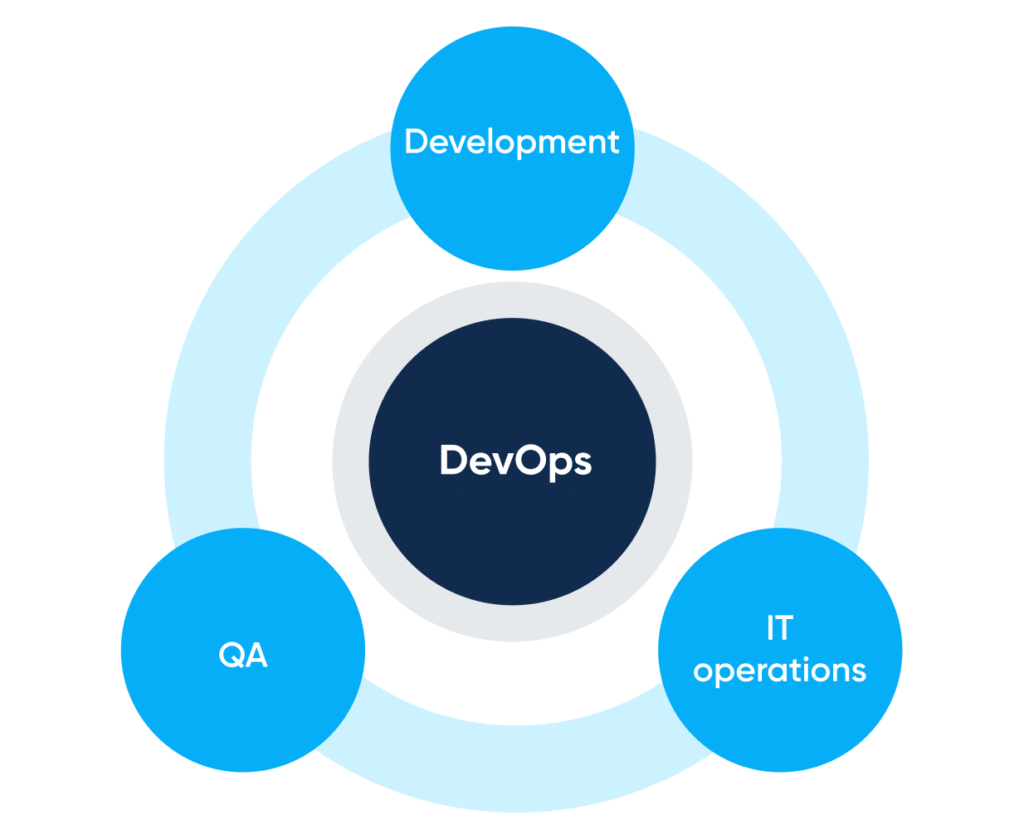
Main parts of DevOps. By Abto Software
The practice is implemented to focus on communication and cooperation and reduce the time-to-market. DevOps culture is about joint responsibility, empathy, accountability and smart resource allocation.
In contrast to conventional software development, DevOps practices combine development and operations boosting the efficiency, speed and security of development and deployment.
Why use DevOps practices?
For instance, Continuous Integration & Continuous Delivery (CI/CD) practices provide programmers with an efficient pipeline, which saves valuable resources.
Implementing the CI/CD pipeline, you get 1-2 min of seamlessly automated deployment rather than 10-15 min of standard manual work, which means more time to focus on the high-priority tasks and notably less bugs. Another thing, the system can store all variables and passwords for each environment centrally, enhancing the security of the data.
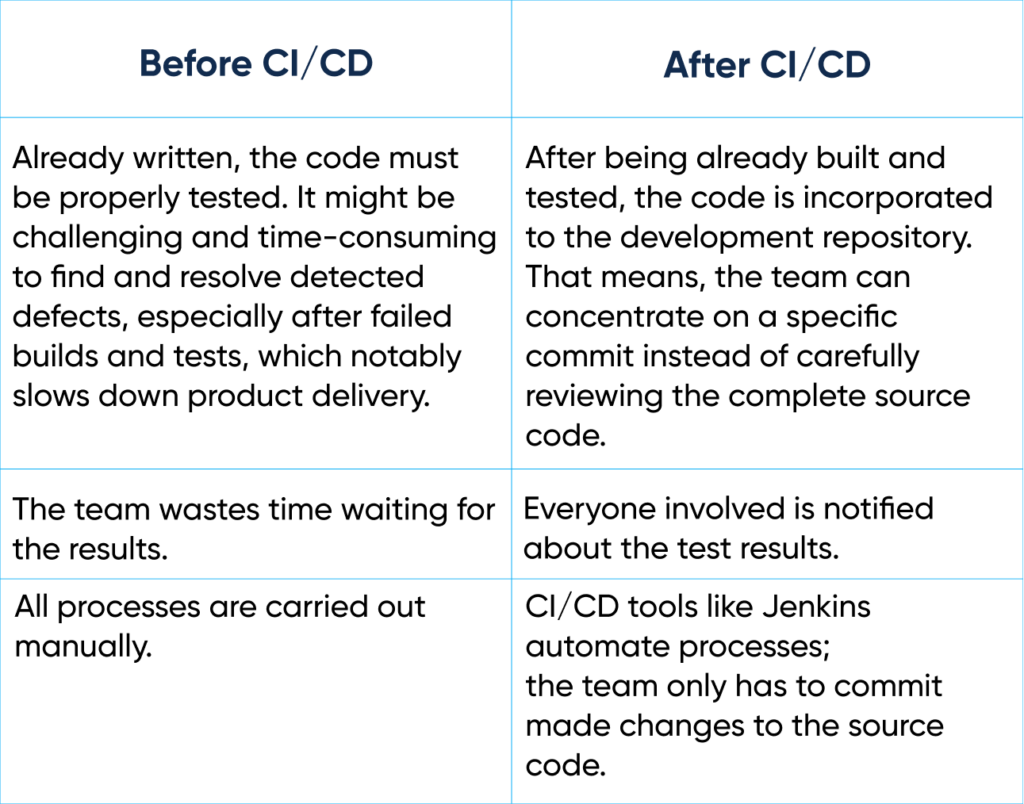
Reasons to imply CI/CD pipeline. Comparison table by Abto Software
Speaking about business value, DevOps practices benefit businesses by saving financial and human resources, reducing time-to-market, and improving product quality, which, relatively, provides for improved functionality, reliability, usability, and maintainability.
The fundamental DevOps principles
When explaining DevOps practices and their significant benefits for business, there are four tenets to mention. The compliance with the four principles described below ensures efficiency of development and deployment, and simplifies communication between involved professionals.
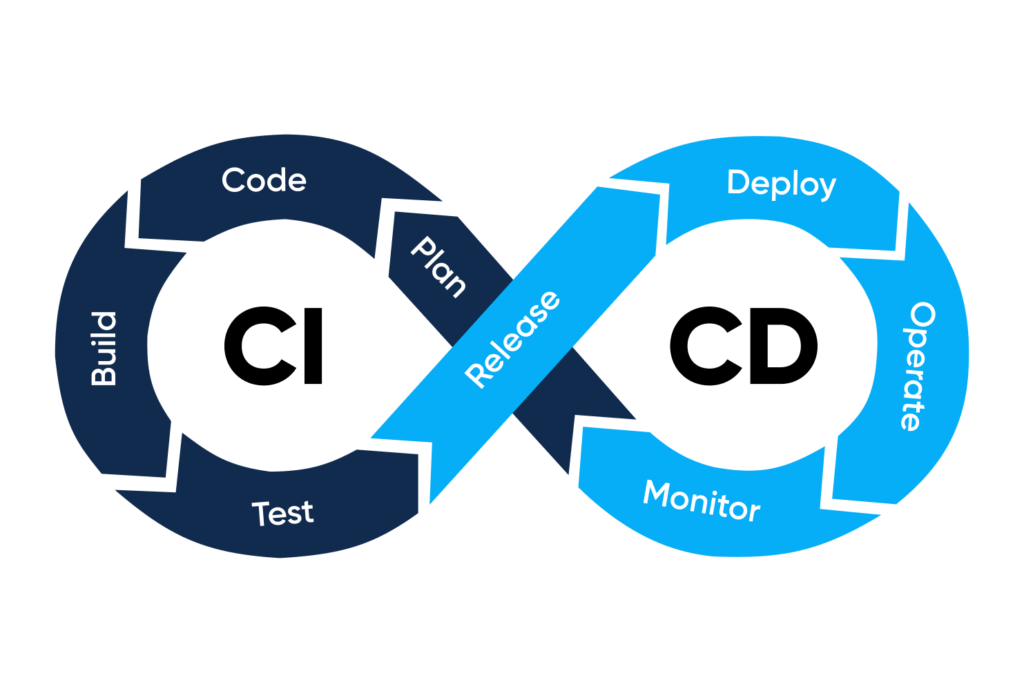
DevOps lifecycle. By Abto Software
The fundamentals to adopt in order to improve code quality and competitiveness:
- Automation of software development lifecycle (SDLC)
DevOps’ cornerstone is automating all design, development, testing, configuration and maintenance processes. Operational automation allows to eliminate time-consuming, repetitive tasks and focus on those major tasks, which cannot be automated by nature.
- Efficient communication and cooperation
These two important principles have also been fundamental for the DevOps processes from the very beginning. To ensure high quality of the final product, all involved team members have to work harmoniously and taking into account each other’s current workload.
- Continuous improvement and minimization of waste
This tenet is about constantly making incremental advancements to the designed product to enhance application, procedure, and employee skill sets.
- Hyperfocus on user needs and short feedback loops
Feedback loops enable customers to follow the development and deployment of the designed product at its different stages to make necessary improvements.
DevOps techniques and methodologies
The application of the below described DevOps techniques and methodologies might enhance code quality, reduce time-to-market, and save financial and human resources.
Continuous integration, continuous delivery, or CI/CD
CI/CD stands for the continuous integration and the continuous delivery or deployment of the designed code. CI/CD notably reduces time-to-market by automating code build, release and final deployment.
Code written by several software developers may be immediately incorporated into the dev repository. Typically, a pull request is used to incorporate code parts. After incorporation of all suggested modifications, the testers might enter the game and test the product for bugs in the created build. And if any bugs are found, they can be fixed before the created build is available for use in production.
The delivery workflow’s automation, which entails building, testing, and delivery, is referred to as the pipeline. Each step might be conducted manually, but automating and coordinating those stages ensures consistency and reduces human error.
There are three steps in a typical pipeline: build, test, and deploy.
At various project stages, the following might also be included:
- Obtaining code from the so-called version control system and starting a build
- Automating tests, including security, quality and compliance checks
- Running required infrastructure steps
- Transferring code to the target environment
- Configuring the environment variables for the target environment
- Pushing components to the associated services, such as web servers, database services, and APIs
- Running so-called continuous tests and roll back environments if tests should fail
- Providing alerts and log data during all stages
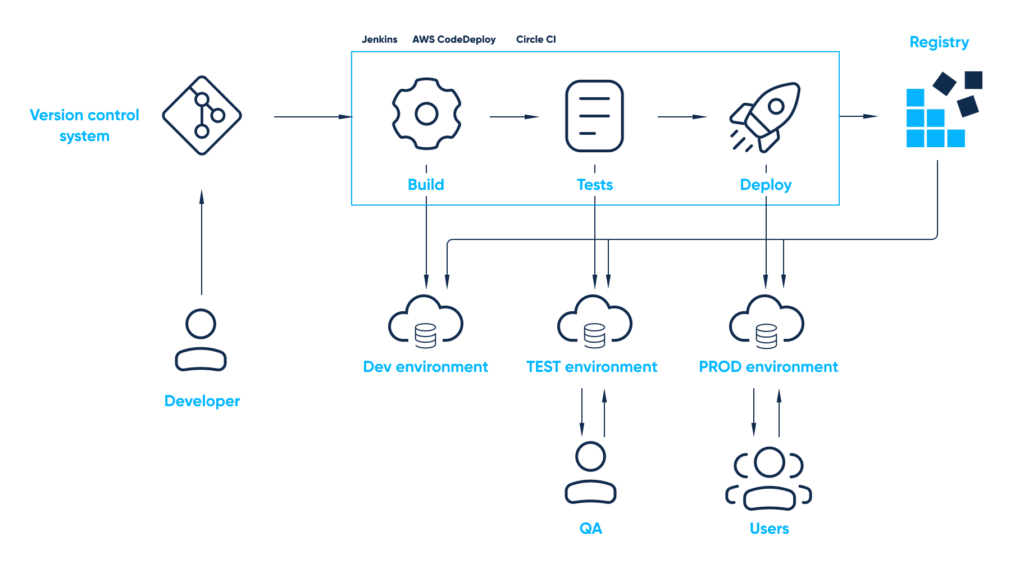
DevOps – workflow automation pipeline. By Abto Software
Cloud computing
Speaking about agile workflows, cloud computing and DevOps provide companies with some major benefits. Thanks to cloud technologies, software developers have access to an unlimited number of features and tools. By introducing cloud computing and DevOps, a company can seamlessly update its product’s functionality. Another thing, there is no limit of features accessible through the cloud.
These technologies facilitate convenient, agile workflows for everyone to participate in the same way.
You can consider both cloud computing and DevOps as two separate technologies to boost overall productivity. But by combining those, you can multiply their numerous advantages and build even more appealing products.
The manner the cloud is constructed and configured is enabling the implementation of all DevOps techniques. The cloud offers resources for a centralized deployment and built-in DevOps assistance.
Continuous monitoring
Continuous monitoring is the DevOps technique commonly implemented to detect potential risks to security. This process might be also extended to detect comparable discrepancies in the company’s infrastructure. Continuous monitoring might assist DevOps teams with analytics and resolve the mentioned critical concerns. The popular tools utilized include Prometheus, Monit, Datadog, and Nagios.
A company may obtain relevant information from many separate ecosystems by using continuous monitoring, which then can be used to implement robust security measures (threat detection, breach response, and more). Continuous monitoring also helps keep track of the overall condition of development and operations.
The pros and cons of adopting DevOps practices
Main benefits of the DevOps methodology
- Improved, fast software development
By automating routine processes, team members may ensure those processes are run without surveillance. Another thing, those scripts already automated create templates that can be utilized consistently across several deployments.
- Less complexity and quicker problem solving
The collaborative DevOps environment provides for the culture of sharing field knowledge across teammates. The teams are encouraged to give and receive honest feedback to determine and resolve potential problems.
- Improved availability and scalability
By introducing a more agile strategy and using automated scripts to match workload requirements, the team can quickly spin up new infrastructure from both on-premises and cloud infrastructure.
- More stable operating environment
By implementing a flexible and organized operating strategy, the team can stay on top of changes and updates while stabilizing the workplace and maintaining overall productivity.
- Smarter allocation of resources
The configuration can also be applied to instances in various deployment environments to ensure that the designed application does not run out of resources.
- Further automation
The solid DevOps environment, in contrast to conventional delivery techniques, helps deliver product release after release and make necessary adjustments on an ongoing basis as opposed to one major release.
- Reduced costs
A business may reduce management and production costs by streamlining software development and fostering efficient communication and cooperation.
- Greater inventiveness
By automating routine processes, including testing and drafting project specifications, the team may focus more on priority tasks and foster greater creativity.
Potential challenges of the DevOps methodology
- Adoption challenges
Some managers, team members and even some stakeholders find adopting DevOps practices too complicated. In such a situation, it’s important to emphasize that transitioning to the DevOps methodology might improve several processes.
- Switching from expertise teams to flexible, cross-functional teams
In the traditional scenario, IT teams were responsible for the software development of the designed product. When talking about more agile strategies, IT teams take responsibility for the whole process, which includes planning, designing, software development, testing, deployment, and maintenance.
- Dependence on the tools
DevOps practices are not about tools, but more about culture and changing the way that problems are solved. The best possible advice for teams is to focus more on communication and cooperation instead of focusing on implementing the right tools.
- Conflicting tools
When adopting DevOps practices, the team should understand that devs and ops have very different toolsets. That means, it’s crucial to decide on more unified metrics and merge used tools.
- The switch to microservices
Maintaining a legacy infrastructure and using outdated applications may keep your company behind rivals. Replacing that outdated infrastructure with microservices might accelerate overall productivity.
- Not being truly aware of what DevOps practices really entails
Although the described practice has been around for some time, the majority doesn’t understand it properly. Even worse, many consider it as the substitute for the agile methodology and some other approaches.
When is the time to adopt DevOps practices?
Every company is facing unique problems, but there are some common issues associated with product release. Typical problems commonly include:
- too positive time estimates,
- insufficient allocated human resources,
- bottlenecks with third-party integrations, and other.
DevOps practices help teams navigate through software development and other project stages more quickly. There are no excessive manual processes, drawn-out evaluations or delays.
Every incorporated code modification is minor and reversible by nature, which eliminates possible problems. Another thing, every change is reviewed by the whole team, which makes incident management much easier.
DevOps practices is the right strategy to adopt to optimize and significantly speed up software development and release.
Switch to DevOps practices and enjoy
- Reduced costs
With adopted DevOps practices, IT teams need fewer human resources to get the job done well.
- Reduces time-to-market
By automating repetitive tasks, IT teams can focus on those important processes, which cannot be automated.
- Reduced risks
By implementing CI/CD pipelines, IT teams can standardize release procedures across projects and, accordingly, reduce risks.
- Improved communication and cooperation
DevOps enables team members to review every modification and comment on those to improve the code.
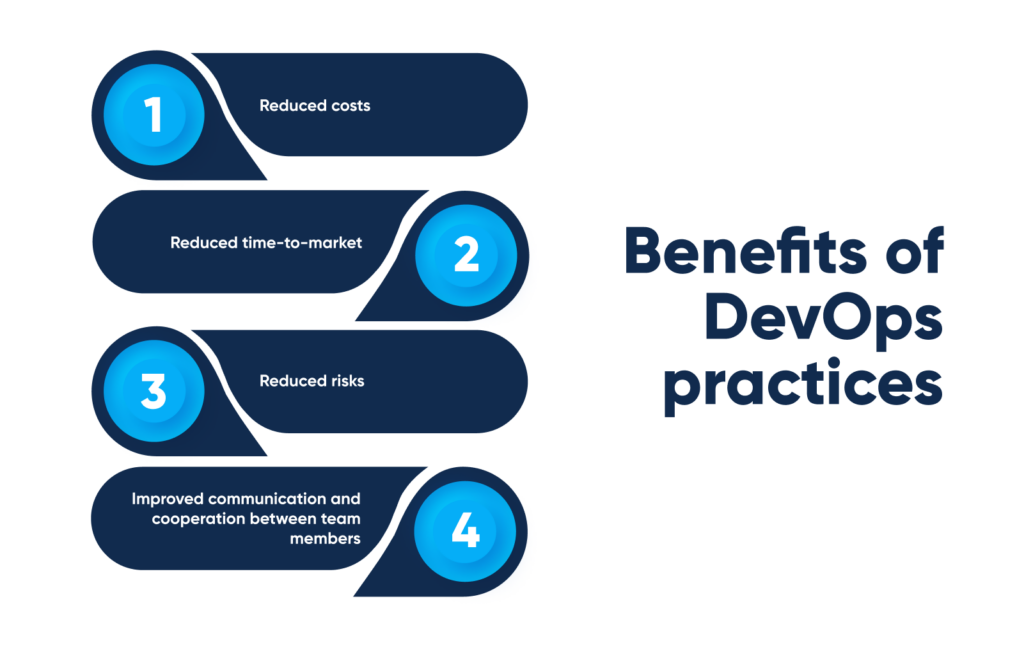
Benefits of switching to DevOps practices. By Abto Software
Abto Software’s DevOps stack
Cloud platforms:
- AWS
- GCP
- Microsoft Azure
Production-identical environments for development:
- Docker
- Kubernetes
IaaC tools:
- Ansible
- Chef
- Terraform
CI/CD tools:
- Jenkins
- CircleCI
- AWS CodePipeline
- GitAction
Source control, collaborative coding:
- Git
- GitLab
- GitHub
- BitBucket
Application and server performance monitoring tools:
- Grafana
- Prometheus
- ElasticSearch
- Kibana
- Nagios
How we can help
Adhering to the industry’s best practices, we streamline every stage of the software development and provide the following DevOps services:
- DevOps implementation
- CI/CD implementation
- Cloud management
- Infrastructure management
- Container & orchestration optimization
- Database management
Contact us to get DevOps implementation done right!

